Bhopal Disaster Case Study: Safety Systems and Risk Analysis Report
VerifiedAdded on 2022/11/14
|15
|3907
|268
Report
AI Summary
This report provides a comprehensive analysis of the Bhopal disaster, focusing on the catastrophic industrial accident that occurred in Bhopal, India, in 1984. The report delves into the background of the event, describing the operations of the Union Carbide India Limited (UCIL) plant, the production of methyl isocyanate (MIC), and the events leading up to the disastrous leakage. It examines the possible causes of the disaster, including slack machinery maintenance, lack of initiative from the MIC supervisor, and inadequate risk and safety management implementation by the company. The report discusses specific safety failures, such as malfunctioning safety valves, a non-functional flare tower, and a dismantled refrigeration system. Furthermore, the report explores preventative measures that could have been taken, including improved asset maintenance, employee training, installation of advanced safety systems, and the establishment of emergency medical units. The report concludes by emphasizing the critical importance of robust risk management practices and stakeholder accountability in preventing similar industrial disasters in the future, highlighting the devastating consequences of neglecting safety protocols.
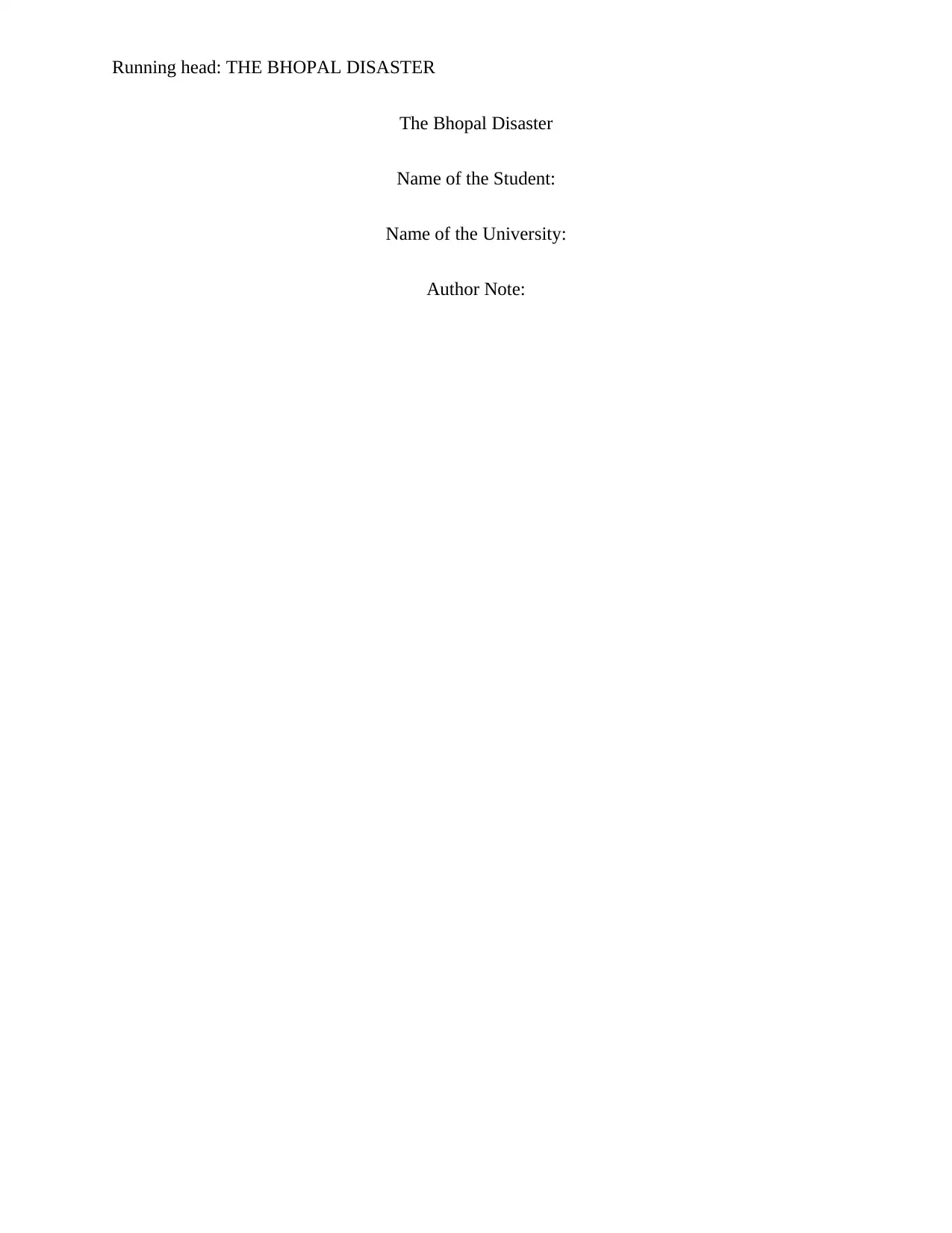
Running head: THE BHOPAL DISASTER
The Bhopal Disaster
Name of the Student:
Name of the University:
Author Note:
The Bhopal Disaster
Name of the Student:
Name of the University:
Author Note:
Paraphrase This Document
Need a fresh take? Get an instant paraphrase of this document with our AI Paraphraser
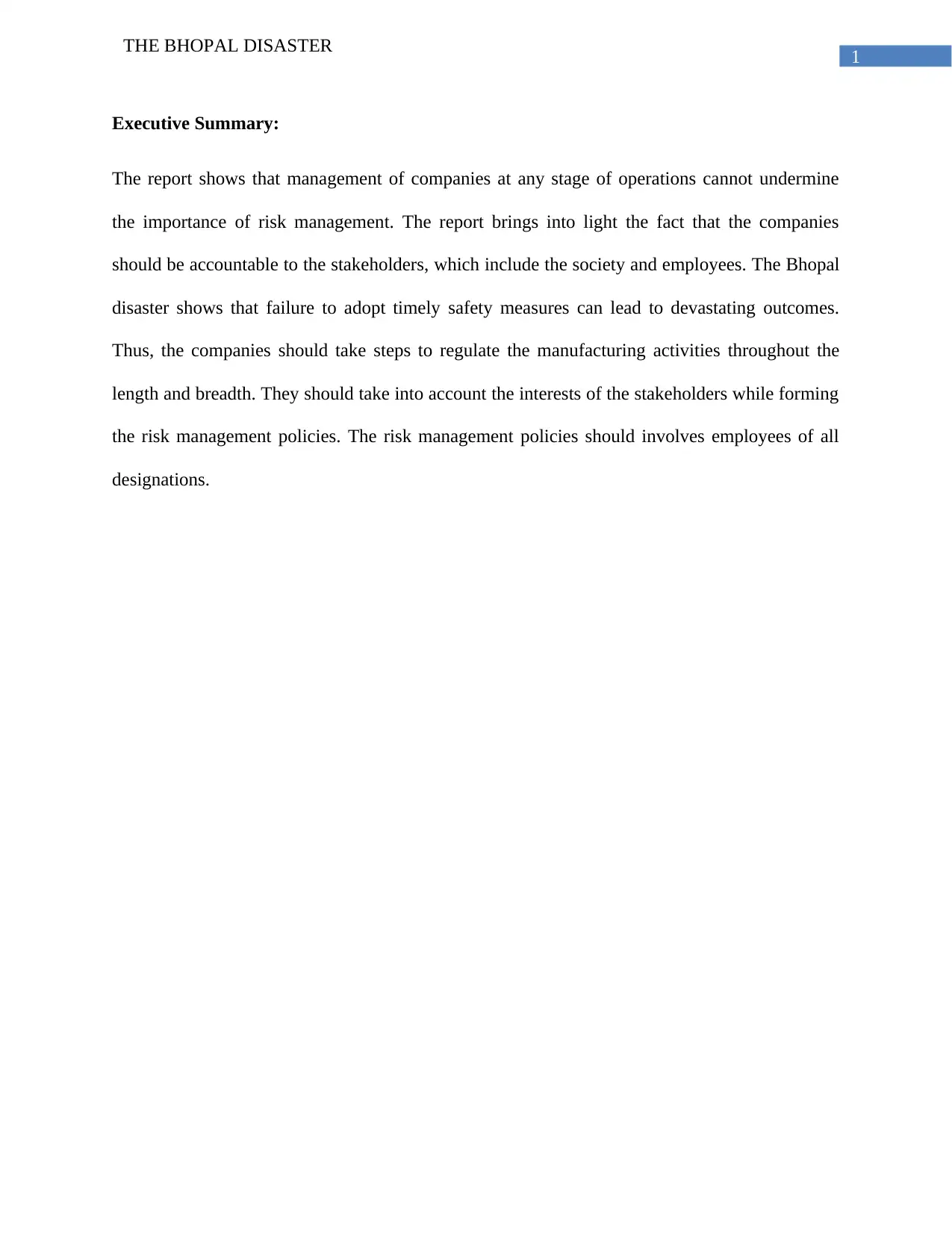
1
THE BHOPAL DISASTER
Executive Summary:
The report shows that management of companies at any stage of operations cannot undermine
the importance of risk management. The report brings into light the fact that the companies
should be accountable to the stakeholders, which include the society and employees. The Bhopal
disaster shows that failure to adopt timely safety measures can lead to devastating outcomes.
Thus, the companies should take steps to regulate the manufacturing activities throughout the
length and breadth. They should take into account the interests of the stakeholders while forming
the risk management policies. The risk management policies should involves employees of all
designations.
THE BHOPAL DISASTER
Executive Summary:
The report shows that management of companies at any stage of operations cannot undermine
the importance of risk management. The report brings into light the fact that the companies
should be accountable to the stakeholders, which include the society and employees. The Bhopal
disaster shows that failure to adopt timely safety measures can lead to devastating outcomes.
Thus, the companies should take steps to regulate the manufacturing activities throughout the
length and breadth. They should take into account the interests of the stakeholders while forming
the risk management policies. The risk management policies should involves employees of all
designations.
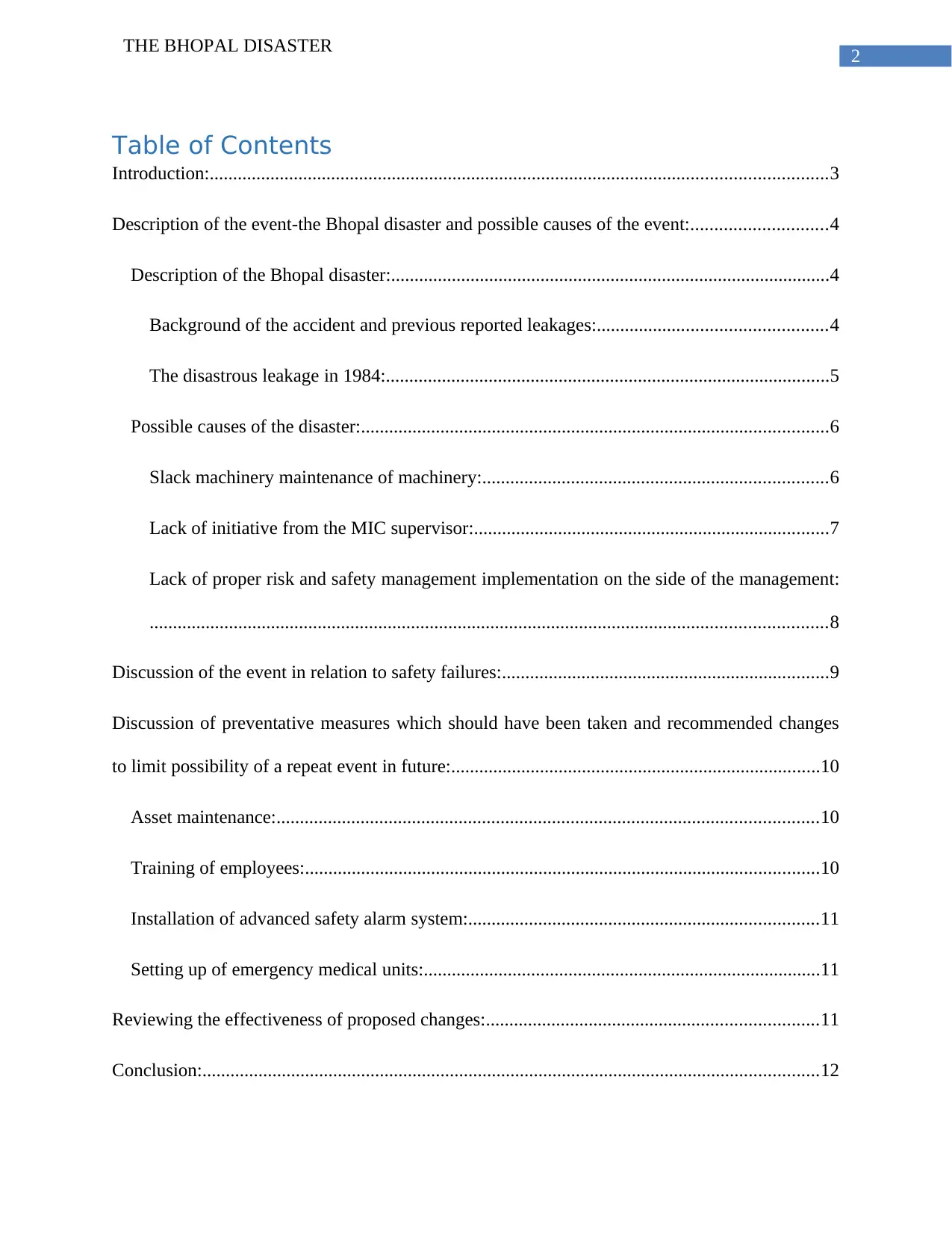
2
THE BHOPAL DISASTER
Table of Contents
Introduction:....................................................................................................................................3
Description of the event-the Bhopal disaster and possible causes of the event:.............................4
Description of the Bhopal disaster:..............................................................................................4
Background of the accident and previous reported leakages:.................................................4
The disastrous leakage in 1984:...............................................................................................5
Possible causes of the disaster:....................................................................................................6
Slack machinery maintenance of machinery:..........................................................................6
Lack of initiative from the MIC supervisor:............................................................................7
Lack of proper risk and safety management implementation on the side of the management:
.................................................................................................................................................8
Discussion of the event in relation to safety failures:......................................................................9
Discussion of preventative measures which should have been taken and recommended changes
to limit possibility of a repeat event in future:...............................................................................10
Asset maintenance:....................................................................................................................10
Training of employees:..............................................................................................................10
Installation of advanced safety alarm system:...........................................................................11
Setting up of emergency medical units:.....................................................................................11
Reviewing the effectiveness of proposed changes:.......................................................................11
Conclusion:....................................................................................................................................12
THE BHOPAL DISASTER
Table of Contents
Introduction:....................................................................................................................................3
Description of the event-the Bhopal disaster and possible causes of the event:.............................4
Description of the Bhopal disaster:..............................................................................................4
Background of the accident and previous reported leakages:.................................................4
The disastrous leakage in 1984:...............................................................................................5
Possible causes of the disaster:....................................................................................................6
Slack machinery maintenance of machinery:..........................................................................6
Lack of initiative from the MIC supervisor:............................................................................7
Lack of proper risk and safety management implementation on the side of the management:
.................................................................................................................................................8
Discussion of the event in relation to safety failures:......................................................................9
Discussion of preventative measures which should have been taken and recommended changes
to limit possibility of a repeat event in future:...............................................................................10
Asset maintenance:....................................................................................................................10
Training of employees:..............................................................................................................10
Installation of advanced safety alarm system:...........................................................................11
Setting up of emergency medical units:.....................................................................................11
Reviewing the effectiveness of proposed changes:.......................................................................11
Conclusion:....................................................................................................................................12
⊘ This is a preview!⊘
Do you want full access?
Subscribe today to unlock all pages.

Trusted by 1+ million students worldwide
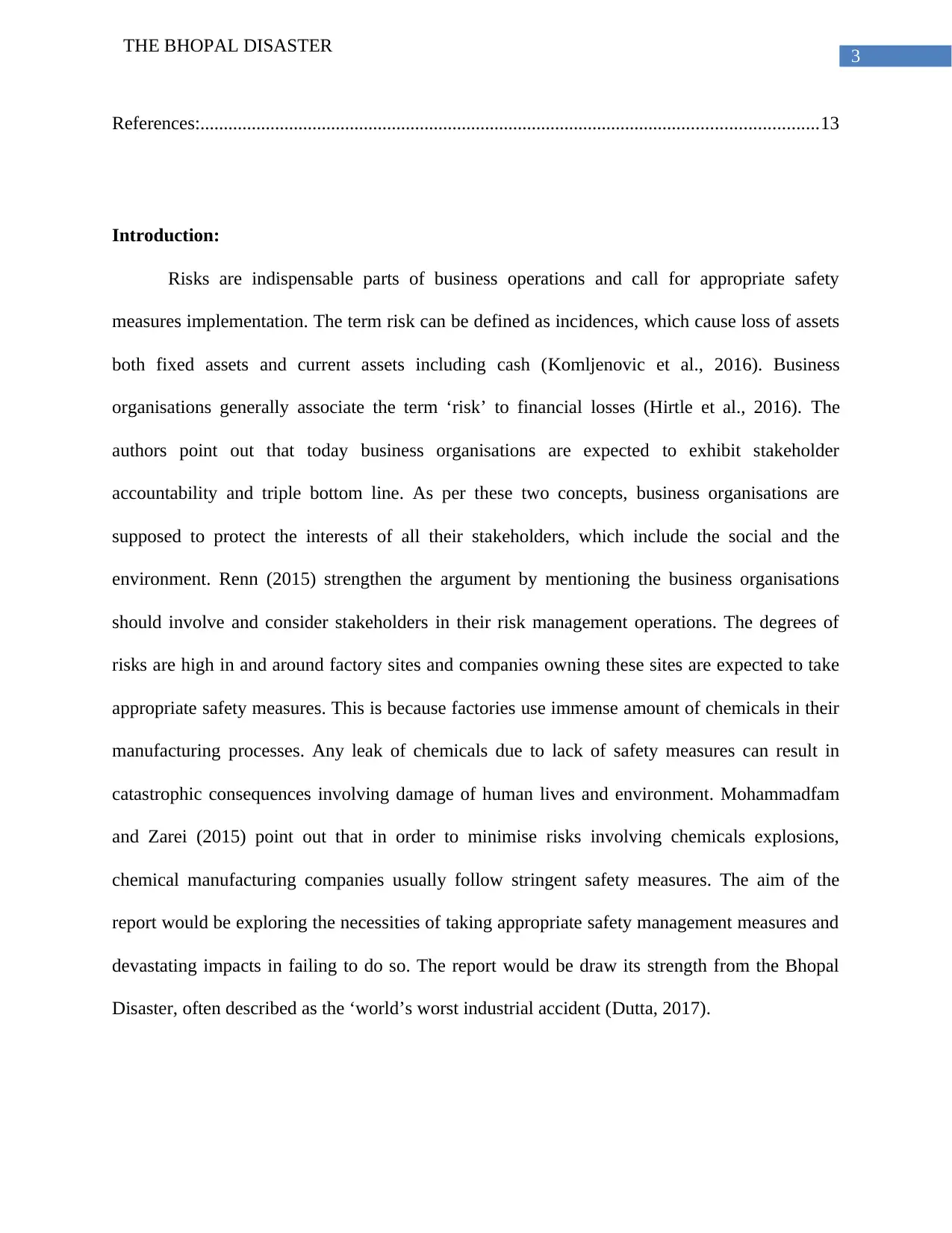
3
THE BHOPAL DISASTER
References:....................................................................................................................................13
Introduction:
Risks are indispensable parts of business operations and call for appropriate safety
measures implementation. The term risk can be defined as incidences, which cause loss of assets
both fixed assets and current assets including cash (Komljenovic et al., 2016). Business
organisations generally associate the term ‘risk’ to financial losses (Hirtle et al., 2016). The
authors point out that today business organisations are expected to exhibit stakeholder
accountability and triple bottom line. As per these two concepts, business organisations are
supposed to protect the interests of all their stakeholders, which include the social and the
environment. Renn (2015) strengthen the argument by mentioning the business organisations
should involve and consider stakeholders in their risk management operations. The degrees of
risks are high in and around factory sites and companies owning these sites are expected to take
appropriate safety measures. This is because factories use immense amount of chemicals in their
manufacturing processes. Any leak of chemicals due to lack of safety measures can result in
catastrophic consequences involving damage of human lives and environment. Mohammadfam
and Zarei (2015) point out that in order to minimise risks involving chemicals explosions,
chemical manufacturing companies usually follow stringent safety measures. The aim of the
report would be exploring the necessities of taking appropriate safety management measures and
devastating impacts in failing to do so. The report would be draw its strength from the Bhopal
Disaster, often described as the ‘world’s worst industrial accident (Dutta, 2017).
THE BHOPAL DISASTER
References:....................................................................................................................................13
Introduction:
Risks are indispensable parts of business operations and call for appropriate safety
measures implementation. The term risk can be defined as incidences, which cause loss of assets
both fixed assets and current assets including cash (Komljenovic et al., 2016). Business
organisations generally associate the term ‘risk’ to financial losses (Hirtle et al., 2016). The
authors point out that today business organisations are expected to exhibit stakeholder
accountability and triple bottom line. As per these two concepts, business organisations are
supposed to protect the interests of all their stakeholders, which include the social and the
environment. Renn (2015) strengthen the argument by mentioning the business organisations
should involve and consider stakeholders in their risk management operations. The degrees of
risks are high in and around factory sites and companies owning these sites are expected to take
appropriate safety measures. This is because factories use immense amount of chemicals in their
manufacturing processes. Any leak of chemicals due to lack of safety measures can result in
catastrophic consequences involving damage of human lives and environment. Mohammadfam
and Zarei (2015) point out that in order to minimise risks involving chemicals explosions,
chemical manufacturing companies usually follow stringent safety measures. The aim of the
report would be exploring the necessities of taking appropriate safety management measures and
devastating impacts in failing to do so. The report would be draw its strength from the Bhopal
Disaster, often described as the ‘world’s worst industrial accident (Dutta, 2017).
Paraphrase This Document
Need a fresh take? Get an instant paraphrase of this document with our AI Paraphraser
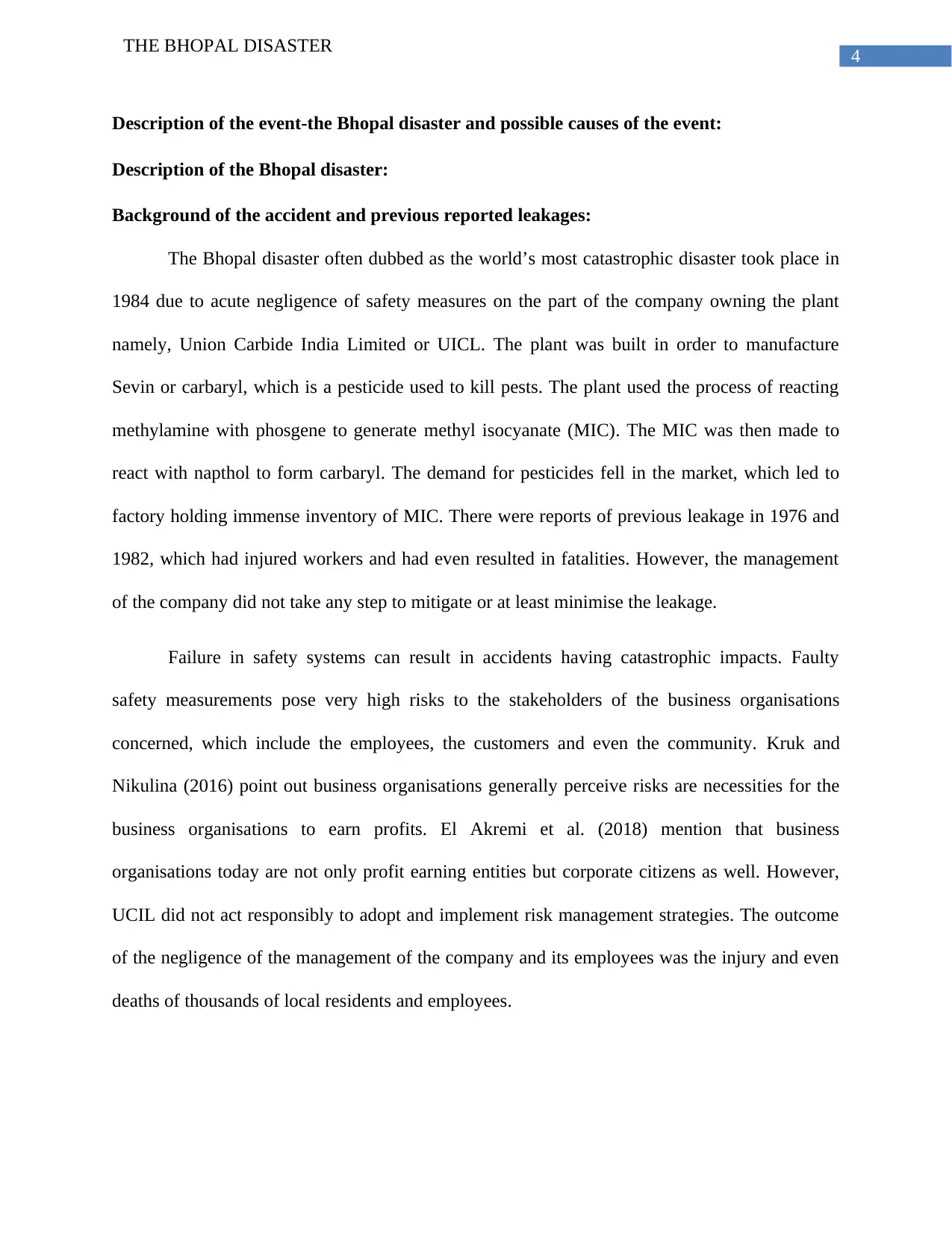
4
THE BHOPAL DISASTER
Description of the event-the Bhopal disaster and possible causes of the event:
Description of the Bhopal disaster:
Background of the accident and previous reported leakages:
The Bhopal disaster often dubbed as the world’s most catastrophic disaster took place in
1984 due to acute negligence of safety measures on the part of the company owning the plant
namely, Union Carbide India Limited or UICL. The plant was built in order to manufacture
Sevin or carbaryl, which is a pesticide used to kill pests. The plant used the process of reacting
methylamine with phosgene to generate methyl isocyanate (MIC). The MIC was then made to
react with napthol to form carbaryl. The demand for pesticides fell in the market, which led to
factory holding immense inventory of MIC. There were reports of previous leakage in 1976 and
1982, which had injured workers and had even resulted in fatalities. However, the management
of the company did not take any step to mitigate or at least minimise the leakage.
Failure in safety systems can result in accidents having catastrophic impacts. Faulty
safety measurements pose very high risks to the stakeholders of the business organisations
concerned, which include the employees, the customers and even the community. Kruk and
Nikulina (2016) point out business organisations generally perceive risks are necessities for the
business organisations to earn profits. El Akremi et al. (2018) mention that business
organisations today are not only profit earning entities but corporate citizens as well. However,
UCIL did not act responsibly to adopt and implement risk management strategies. The outcome
of the negligence of the management of the company and its employees was the injury and even
deaths of thousands of local residents and employees.
THE BHOPAL DISASTER
Description of the event-the Bhopal disaster and possible causes of the event:
Description of the Bhopal disaster:
Background of the accident and previous reported leakages:
The Bhopal disaster often dubbed as the world’s most catastrophic disaster took place in
1984 due to acute negligence of safety measures on the part of the company owning the plant
namely, Union Carbide India Limited or UICL. The plant was built in order to manufacture
Sevin or carbaryl, which is a pesticide used to kill pests. The plant used the process of reacting
methylamine with phosgene to generate methyl isocyanate (MIC). The MIC was then made to
react with napthol to form carbaryl. The demand for pesticides fell in the market, which led to
factory holding immense inventory of MIC. There were reports of previous leakage in 1976 and
1982, which had injured workers and had even resulted in fatalities. However, the management
of the company did not take any step to mitigate or at least minimise the leakage.
Failure in safety systems can result in accidents having catastrophic impacts. Faulty
safety measurements pose very high risks to the stakeholders of the business organisations
concerned, which include the employees, the customers and even the community. Kruk and
Nikulina (2016) point out business organisations generally perceive risks are necessities for the
business organisations to earn profits. El Akremi et al. (2018) mention that business
organisations today are not only profit earning entities but corporate citizens as well. However,
UCIL did not act responsibly to adopt and implement risk management strategies. The outcome
of the negligence of the management of the company and its employees was the injury and even
deaths of thousands of local residents and employees.
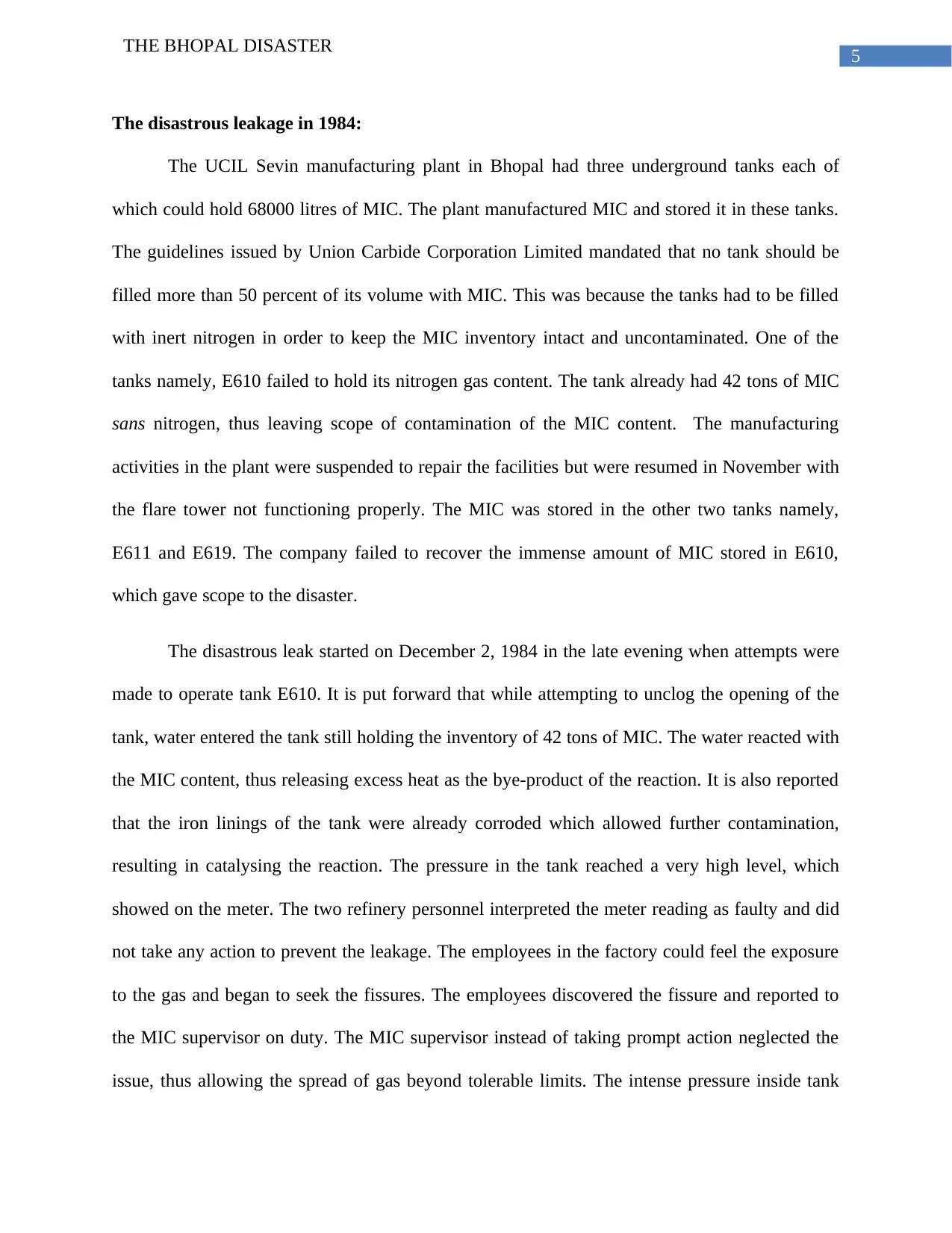
5
THE BHOPAL DISASTER
The disastrous leakage in 1984:
The UCIL Sevin manufacturing plant in Bhopal had three underground tanks each of
which could hold 68000 litres of MIC. The plant manufactured MIC and stored it in these tanks.
The guidelines issued by Union Carbide Corporation Limited mandated that no tank should be
filled more than 50 percent of its volume with MIC. This was because the tanks had to be filled
with inert nitrogen in order to keep the MIC inventory intact and uncontaminated. One of the
tanks namely, E610 failed to hold its nitrogen gas content. The tank already had 42 tons of MIC
sans nitrogen, thus leaving scope of contamination of the MIC content. The manufacturing
activities in the plant were suspended to repair the facilities but were resumed in November with
the flare tower not functioning properly. The MIC was stored in the other two tanks namely,
E611 and E619. The company failed to recover the immense amount of MIC stored in E610,
which gave scope to the disaster.
The disastrous leak started on December 2, 1984 in the late evening when attempts were
made to operate tank E610. It is put forward that while attempting to unclog the opening of the
tank, water entered the tank still holding the inventory of 42 tons of MIC. The water reacted with
the MIC content, thus releasing excess heat as the bye-product of the reaction. It is also reported
that the iron linings of the tank were already corroded which allowed further contamination,
resulting in catalysing the reaction. The pressure in the tank reached a very high level, which
showed on the meter. The two refinery personnel interpreted the meter reading as faulty and did
not take any action to prevent the leakage. The employees in the factory could feel the exposure
to the gas and began to seek the fissures. The employees discovered the fissure and reported to
the MIC supervisor on duty. The MIC supervisor instead of taking prompt action neglected the
issue, thus allowing the spread of gas beyond tolerable limits. The intense pressure inside tank
THE BHOPAL DISASTER
The disastrous leakage in 1984:
The UCIL Sevin manufacturing plant in Bhopal had three underground tanks each of
which could hold 68000 litres of MIC. The plant manufactured MIC and stored it in these tanks.
The guidelines issued by Union Carbide Corporation Limited mandated that no tank should be
filled more than 50 percent of its volume with MIC. This was because the tanks had to be filled
with inert nitrogen in order to keep the MIC inventory intact and uncontaminated. One of the
tanks namely, E610 failed to hold its nitrogen gas content. The tank already had 42 tons of MIC
sans nitrogen, thus leaving scope of contamination of the MIC content. The manufacturing
activities in the plant were suspended to repair the facilities but were resumed in November with
the flare tower not functioning properly. The MIC was stored in the other two tanks namely,
E611 and E619. The company failed to recover the immense amount of MIC stored in E610,
which gave scope to the disaster.
The disastrous leak started on December 2, 1984 in the late evening when attempts were
made to operate tank E610. It is put forward that while attempting to unclog the opening of the
tank, water entered the tank still holding the inventory of 42 tons of MIC. The water reacted with
the MIC content, thus releasing excess heat as the bye-product of the reaction. It is also reported
that the iron linings of the tank were already corroded which allowed further contamination,
resulting in catalysing the reaction. The pressure in the tank reached a very high level, which
showed on the meter. The two refinery personnel interpreted the meter reading as faulty and did
not take any action to prevent the leakage. The employees in the factory could feel the exposure
to the gas and began to seek the fissures. The employees discovered the fissure and reported to
the MIC supervisor on duty. The MIC supervisor instead of taking prompt action neglected the
issue, thus allowing the spread of gas beyond tolerable limits. The intense pressure inside tank
⊘ This is a preview!⊘
Do you want full access?
Subscribe today to unlock all pages.

Trusted by 1+ million students worldwide
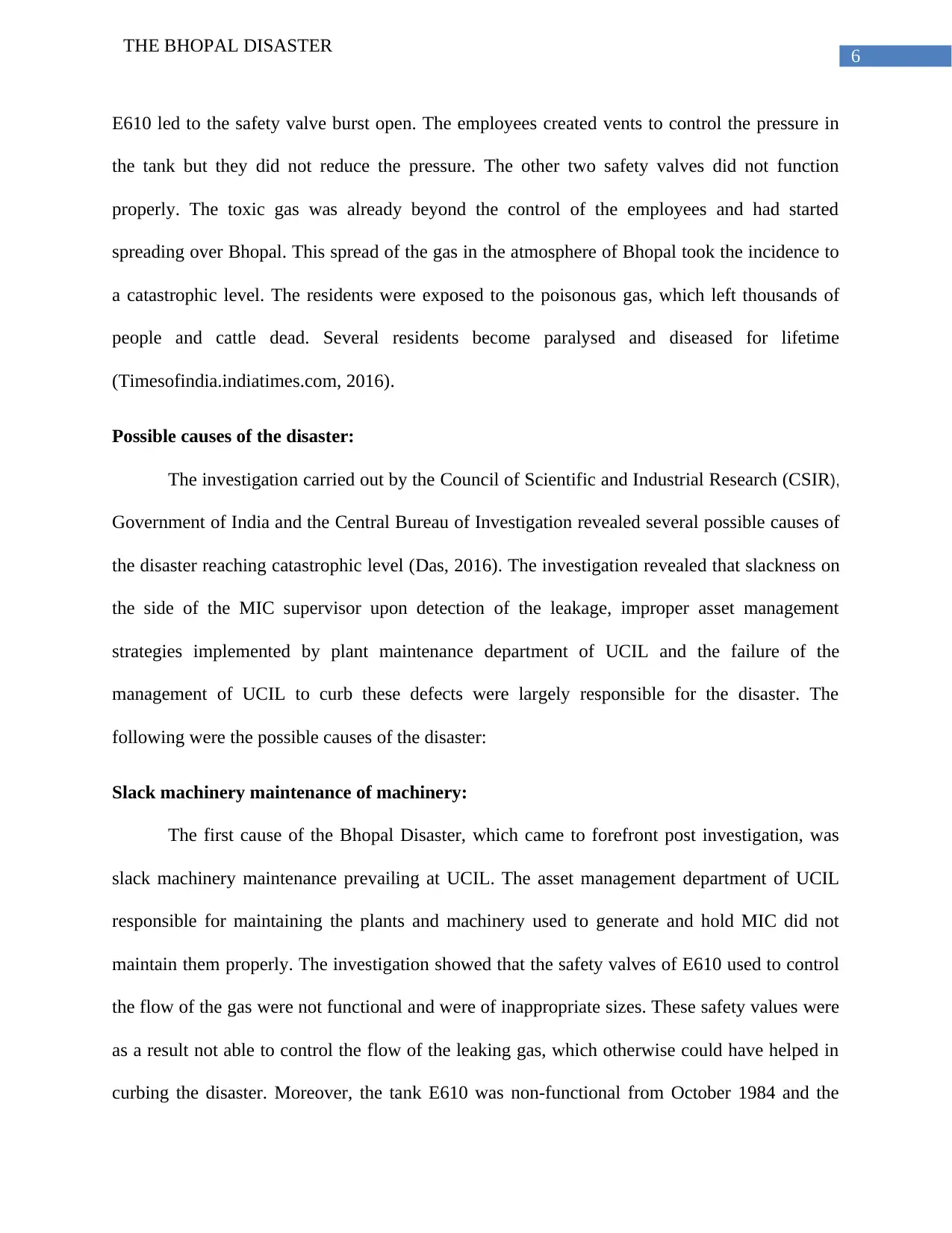
6
THE BHOPAL DISASTER
E610 led to the safety valve burst open. The employees created vents to control the pressure in
the tank but they did not reduce the pressure. The other two safety valves did not function
properly. The toxic gas was already beyond the control of the employees and had started
spreading over Bhopal. This spread of the gas in the atmosphere of Bhopal took the incidence to
a catastrophic level. The residents were exposed to the poisonous gas, which left thousands of
people and cattle dead. Several residents become paralysed and diseased for lifetime
(Timesofindia.indiatimes.com, 2016).
Possible causes of the disaster:
The investigation carried out by the Council of Scientific and Industrial Research (CSIR),
Government of India and the Central Bureau of Investigation revealed several possible causes of
the disaster reaching catastrophic level (Das, 2016). The investigation revealed that slackness on
the side of the MIC supervisor upon detection of the leakage, improper asset management
strategies implemented by plant maintenance department of UCIL and the failure of the
management of UCIL to curb these defects were largely responsible for the disaster. The
following were the possible causes of the disaster:
Slack machinery maintenance of machinery:
The first cause of the Bhopal Disaster, which came to forefront post investigation, was
slack machinery maintenance prevailing at UCIL. The asset management department of UCIL
responsible for maintaining the plants and machinery used to generate and hold MIC did not
maintain them properly. The investigation showed that the safety valves of E610 used to control
the flow of the gas were not functional and were of inappropriate sizes. These safety values were
as a result not able to control the flow of the leaking gas, which otherwise could have helped in
curbing the disaster. Moreover, the tank E610 was non-functional from October 1984 and the
THE BHOPAL DISASTER
E610 led to the safety valve burst open. The employees created vents to control the pressure in
the tank but they did not reduce the pressure. The other two safety valves did not function
properly. The toxic gas was already beyond the control of the employees and had started
spreading over Bhopal. This spread of the gas in the atmosphere of Bhopal took the incidence to
a catastrophic level. The residents were exposed to the poisonous gas, which left thousands of
people and cattle dead. Several residents become paralysed and diseased for lifetime
(Timesofindia.indiatimes.com, 2016).
Possible causes of the disaster:
The investigation carried out by the Council of Scientific and Industrial Research (CSIR),
Government of India and the Central Bureau of Investigation revealed several possible causes of
the disaster reaching catastrophic level (Das, 2016). The investigation revealed that slackness on
the side of the MIC supervisor upon detection of the leakage, improper asset management
strategies implemented by plant maintenance department of UCIL and the failure of the
management of UCIL to curb these defects were largely responsible for the disaster. The
following were the possible causes of the disaster:
Slack machinery maintenance of machinery:
The first cause of the Bhopal Disaster, which came to forefront post investigation, was
slack machinery maintenance prevailing at UCIL. The asset management department of UCIL
responsible for maintaining the plants and machinery used to generate and hold MIC did not
maintain them properly. The investigation showed that the safety valves of E610 used to control
the flow of the gas were not functional and were of inappropriate sizes. These safety values were
as a result not able to control the flow of the leaking gas, which otherwise could have helped in
curbing the disaster. Moreover, the tank E610 was non-functional from October 1984 and the
Paraphrase This Document
Need a fresh take? Get an instant paraphrase of this document with our AI Paraphraser
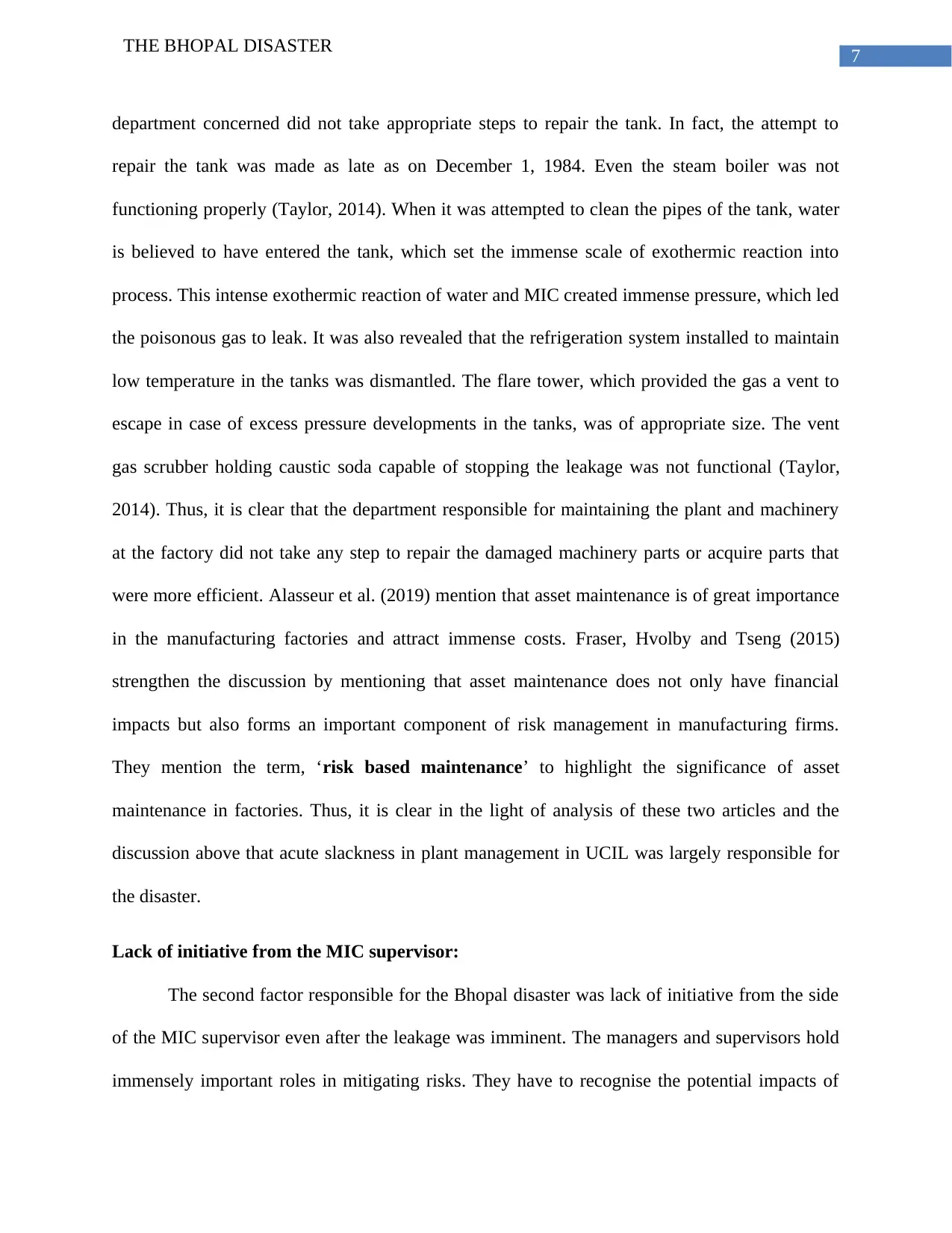
7
THE BHOPAL DISASTER
department concerned did not take appropriate steps to repair the tank. In fact, the attempt to
repair the tank was made as late as on December 1, 1984. Even the steam boiler was not
functioning properly (Taylor, 2014). When it was attempted to clean the pipes of the tank, water
is believed to have entered the tank, which set the immense scale of exothermic reaction into
process. This intense exothermic reaction of water and MIC created immense pressure, which led
the poisonous gas to leak. It was also revealed that the refrigeration system installed to maintain
low temperature in the tanks was dismantled. The flare tower, which provided the gas a vent to
escape in case of excess pressure developments in the tanks, was of appropriate size. The vent
gas scrubber holding caustic soda capable of stopping the leakage was not functional (Taylor,
2014). Thus, it is clear that the department responsible for maintaining the plant and machinery
at the factory did not take any step to repair the damaged machinery parts or acquire parts that
were more efficient. Alasseur et al. (2019) mention that asset maintenance is of great importance
in the manufacturing factories and attract immense costs. Fraser, Hvolby and Tseng (2015)
strengthen the discussion by mentioning that asset maintenance does not only have financial
impacts but also forms an important component of risk management in manufacturing firms.
They mention the term, ‘risk based maintenance’ to highlight the significance of asset
maintenance in factories. Thus, it is clear in the light of analysis of these two articles and the
discussion above that acute slackness in plant management in UCIL was largely responsible for
the disaster.
Lack of initiative from the MIC supervisor:
The second factor responsible for the Bhopal disaster was lack of initiative from the side
of the MIC supervisor even after the leakage was imminent. The managers and supervisors hold
immensely important roles in mitigating risks. They have to recognise the potential impacts of
THE BHOPAL DISASTER
department concerned did not take appropriate steps to repair the tank. In fact, the attempt to
repair the tank was made as late as on December 1, 1984. Even the steam boiler was not
functioning properly (Taylor, 2014). When it was attempted to clean the pipes of the tank, water
is believed to have entered the tank, which set the immense scale of exothermic reaction into
process. This intense exothermic reaction of water and MIC created immense pressure, which led
the poisonous gas to leak. It was also revealed that the refrigeration system installed to maintain
low temperature in the tanks was dismantled. The flare tower, which provided the gas a vent to
escape in case of excess pressure developments in the tanks, was of appropriate size. The vent
gas scrubber holding caustic soda capable of stopping the leakage was not functional (Taylor,
2014). Thus, it is clear that the department responsible for maintaining the plant and machinery
at the factory did not take any step to repair the damaged machinery parts or acquire parts that
were more efficient. Alasseur et al. (2019) mention that asset maintenance is of great importance
in the manufacturing factories and attract immense costs. Fraser, Hvolby and Tseng (2015)
strengthen the discussion by mentioning that asset maintenance does not only have financial
impacts but also forms an important component of risk management in manufacturing firms.
They mention the term, ‘risk based maintenance’ to highlight the significance of asset
maintenance in factories. Thus, it is clear in the light of analysis of these two articles and the
discussion above that acute slackness in plant management in UCIL was largely responsible for
the disaster.
Lack of initiative from the MIC supervisor:
The second factor responsible for the Bhopal disaster was lack of initiative from the side
of the MIC supervisor even after the leakage was imminent. The managers and supervisors hold
immensely important roles in mitigating risks. They have to recognise the potential impacts of
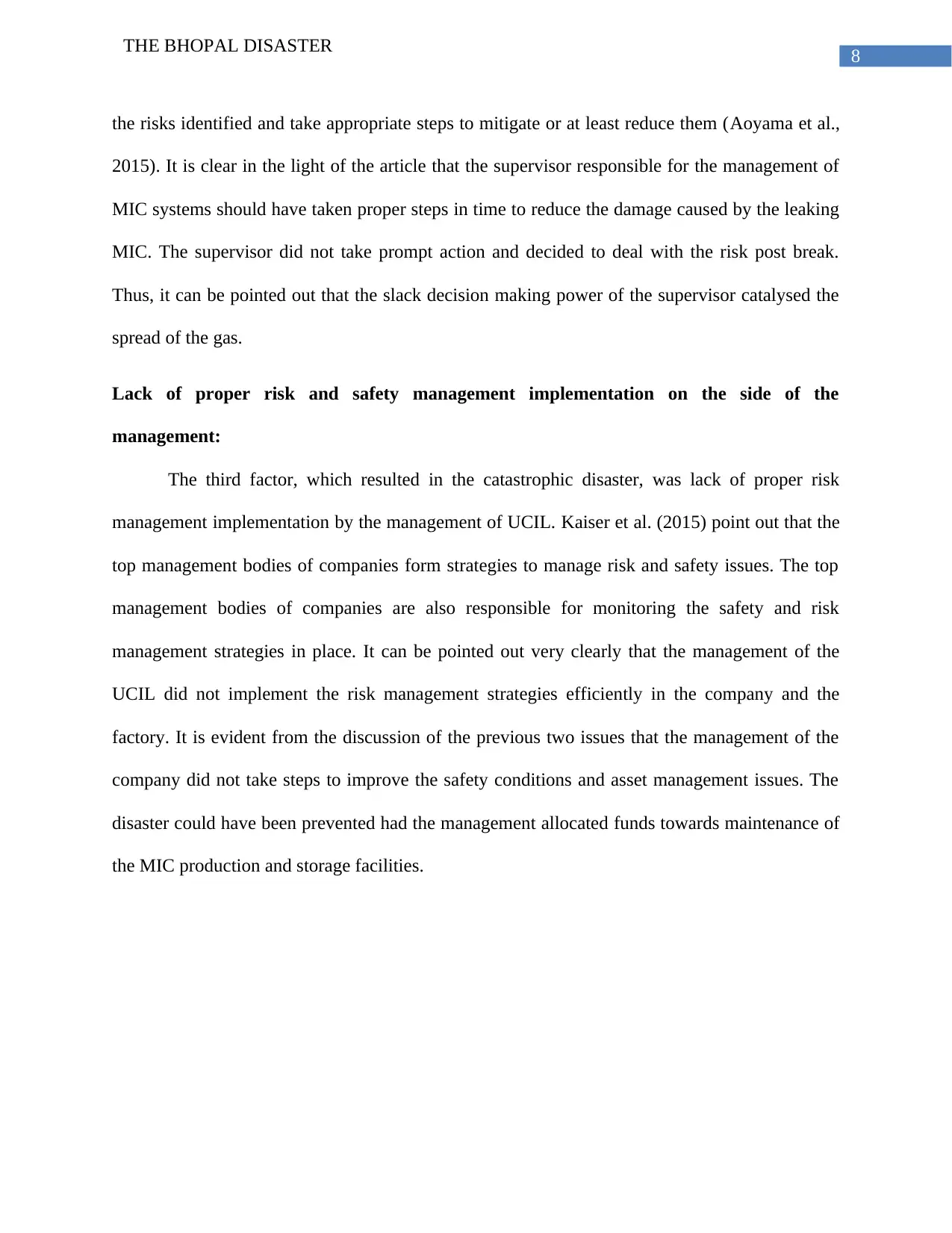
8
THE BHOPAL DISASTER
the risks identified and take appropriate steps to mitigate or at least reduce them (Aoyama et al.,
2015). It is clear in the light of the article that the supervisor responsible for the management of
MIC systems should have taken proper steps in time to reduce the damage caused by the leaking
MIC. The supervisor did not take prompt action and decided to deal with the risk post break.
Thus, it can be pointed out that the slack decision making power of the supervisor catalysed the
spread of the gas.
Lack of proper risk and safety management implementation on the side of the
management:
The third factor, which resulted in the catastrophic disaster, was lack of proper risk
management implementation by the management of UCIL. Kaiser et al. (2015) point out that the
top management bodies of companies form strategies to manage risk and safety issues. The top
management bodies of companies are also responsible for monitoring the safety and risk
management strategies in place. It can be pointed out very clearly that the management of the
UCIL did not implement the risk management strategies efficiently in the company and the
factory. It is evident from the discussion of the previous two issues that the management of the
company did not take steps to improve the safety conditions and asset management issues. The
disaster could have been prevented had the management allocated funds towards maintenance of
the MIC production and storage facilities.
THE BHOPAL DISASTER
the risks identified and take appropriate steps to mitigate or at least reduce them (Aoyama et al.,
2015). It is clear in the light of the article that the supervisor responsible for the management of
MIC systems should have taken proper steps in time to reduce the damage caused by the leaking
MIC. The supervisor did not take prompt action and decided to deal with the risk post break.
Thus, it can be pointed out that the slack decision making power of the supervisor catalysed the
spread of the gas.
Lack of proper risk and safety management implementation on the side of the
management:
The third factor, which resulted in the catastrophic disaster, was lack of proper risk
management implementation by the management of UCIL. Kaiser et al. (2015) point out that the
top management bodies of companies form strategies to manage risk and safety issues. The top
management bodies of companies are also responsible for monitoring the safety and risk
management strategies in place. It can be pointed out very clearly that the management of the
UCIL did not implement the risk management strategies efficiently in the company and the
factory. It is evident from the discussion of the previous two issues that the management of the
company did not take steps to improve the safety conditions and asset management issues. The
disaster could have been prevented had the management allocated funds towards maintenance of
the MIC production and storage facilities.
⊘ This is a preview!⊘
Do you want full access?
Subscribe today to unlock all pages.

Trusted by 1+ million students worldwide
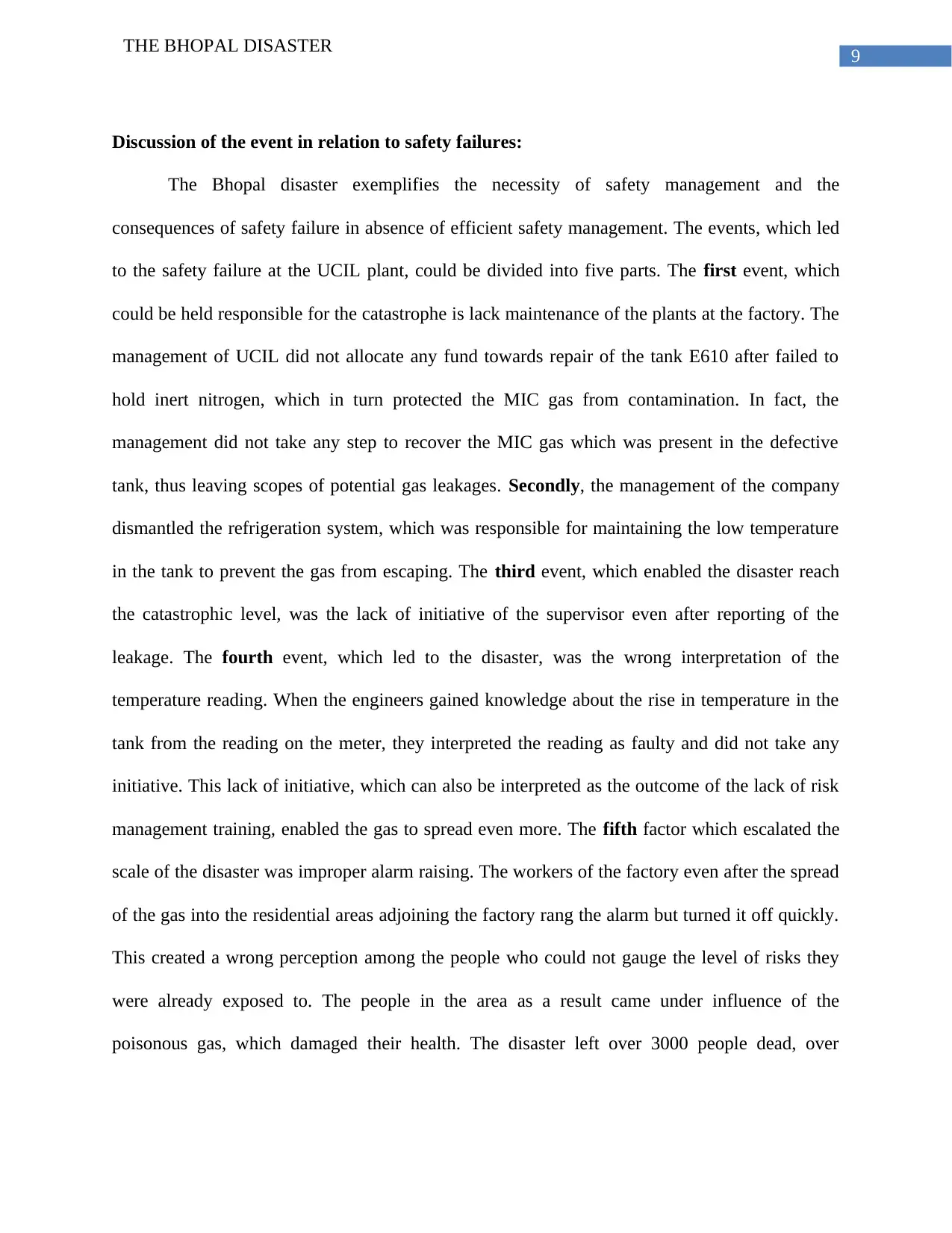
9
THE BHOPAL DISASTER
Discussion of the event in relation to safety failures:
The Bhopal disaster exemplifies the necessity of safety management and the
consequences of safety failure in absence of efficient safety management. The events, which led
to the safety failure at the UCIL plant, could be divided into five parts. The first event, which
could be held responsible for the catastrophe is lack maintenance of the plants at the factory. The
management of UCIL did not allocate any fund towards repair of the tank E610 after failed to
hold inert nitrogen, which in turn protected the MIC gas from contamination. In fact, the
management did not take any step to recover the MIC gas which was present in the defective
tank, thus leaving scopes of potential gas leakages. Secondly, the management of the company
dismantled the refrigeration system, which was responsible for maintaining the low temperature
in the tank to prevent the gas from escaping. The third event, which enabled the disaster reach
the catastrophic level, was the lack of initiative of the supervisor even after reporting of the
leakage. The fourth event, which led to the disaster, was the wrong interpretation of the
temperature reading. When the engineers gained knowledge about the rise in temperature in the
tank from the reading on the meter, they interpreted the reading as faulty and did not take any
initiative. This lack of initiative, which can also be interpreted as the outcome of the lack of risk
management training, enabled the gas to spread even more. The fifth factor which escalated the
scale of the disaster was improper alarm raising. The workers of the factory even after the spread
of the gas into the residential areas adjoining the factory rang the alarm but turned it off quickly.
This created a wrong perception among the people who could not gauge the level of risks they
were already exposed to. The people in the area as a result came under influence of the
poisonous gas, which damaged their health. The disaster left over 3000 people dead, over
THE BHOPAL DISASTER
Discussion of the event in relation to safety failures:
The Bhopal disaster exemplifies the necessity of safety management and the
consequences of safety failure in absence of efficient safety management. The events, which led
to the safety failure at the UCIL plant, could be divided into five parts. The first event, which
could be held responsible for the catastrophe is lack maintenance of the plants at the factory. The
management of UCIL did not allocate any fund towards repair of the tank E610 after failed to
hold inert nitrogen, which in turn protected the MIC gas from contamination. In fact, the
management did not take any step to recover the MIC gas which was present in the defective
tank, thus leaving scopes of potential gas leakages. Secondly, the management of the company
dismantled the refrigeration system, which was responsible for maintaining the low temperature
in the tank to prevent the gas from escaping. The third event, which enabled the disaster reach
the catastrophic level, was the lack of initiative of the supervisor even after reporting of the
leakage. The fourth event, which led to the disaster, was the wrong interpretation of the
temperature reading. When the engineers gained knowledge about the rise in temperature in the
tank from the reading on the meter, they interpreted the reading as faulty and did not take any
initiative. This lack of initiative, which can also be interpreted as the outcome of the lack of risk
management training, enabled the gas to spread even more. The fifth factor which escalated the
scale of the disaster was improper alarm raising. The workers of the factory even after the spread
of the gas into the residential areas adjoining the factory rang the alarm but turned it off quickly.
This created a wrong perception among the people who could not gauge the level of risks they
were already exposed to. The people in the area as a result came under influence of the
poisonous gas, which damaged their health. The disaster left over 3000 people dead, over
Paraphrase This Document
Need a fresh take? Get an instant paraphrase of this document with our AI Paraphraser
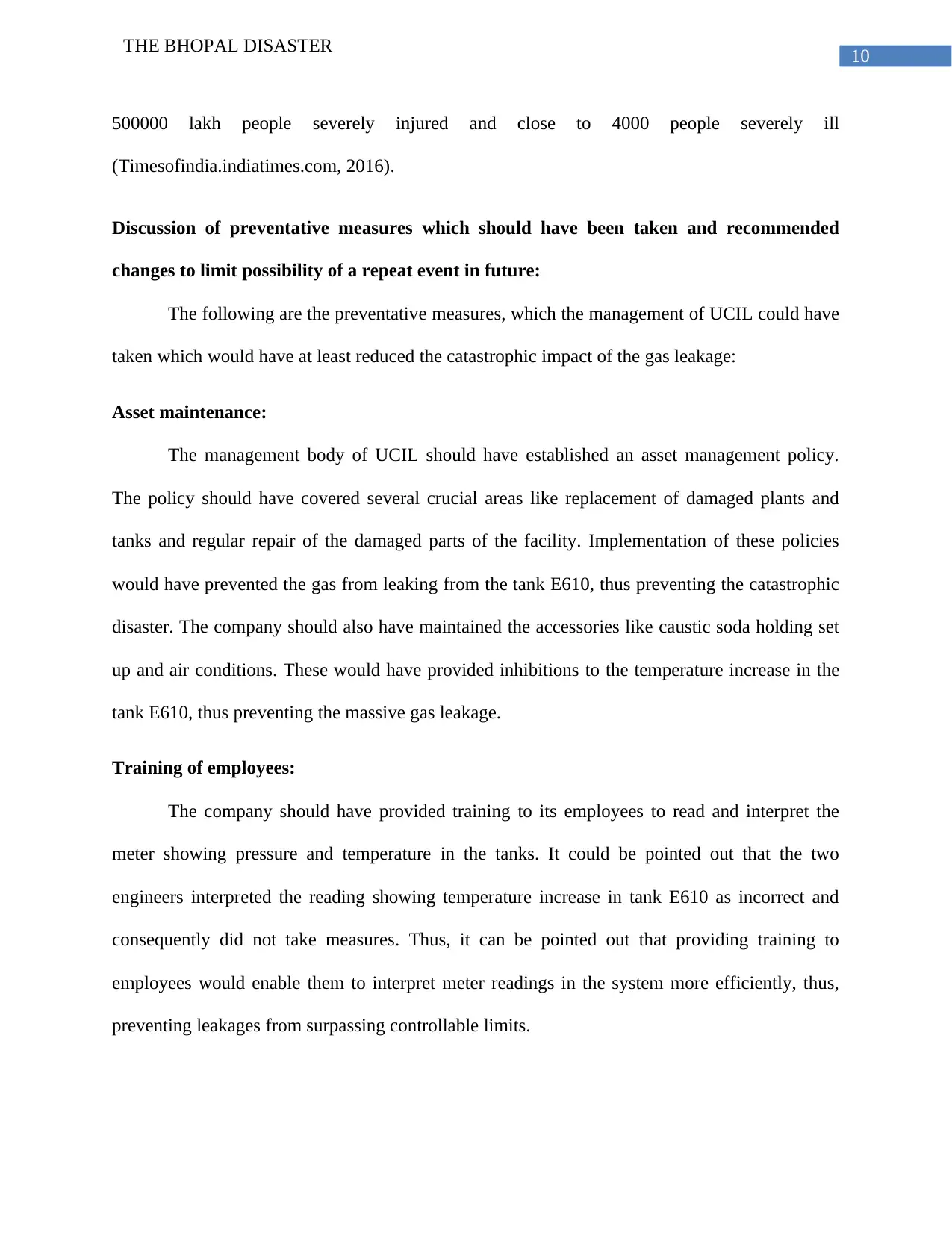
10
THE BHOPAL DISASTER
500000 lakh people severely injured and close to 4000 people severely ill
(Timesofindia.indiatimes.com, 2016).
Discussion of preventative measures which should have been taken and recommended
changes to limit possibility of a repeat event in future:
The following are the preventative measures, which the management of UCIL could have
taken which would have at least reduced the catastrophic impact of the gas leakage:
Asset maintenance:
The management body of UCIL should have established an asset management policy.
The policy should have covered several crucial areas like replacement of damaged plants and
tanks and regular repair of the damaged parts of the facility. Implementation of these policies
would have prevented the gas from leaking from the tank E610, thus preventing the catastrophic
disaster. The company should also have maintained the accessories like caustic soda holding set
up and air conditions. These would have provided inhibitions to the temperature increase in the
tank E610, thus preventing the massive gas leakage.
Training of employees:
The company should have provided training to its employees to read and interpret the
meter showing pressure and temperature in the tanks. It could be pointed out that the two
engineers interpreted the reading showing temperature increase in tank E610 as incorrect and
consequently did not take measures. Thus, it can be pointed out that providing training to
employees would enable them to interpret meter readings in the system more efficiently, thus,
preventing leakages from surpassing controllable limits.
THE BHOPAL DISASTER
500000 lakh people severely injured and close to 4000 people severely ill
(Timesofindia.indiatimes.com, 2016).
Discussion of preventative measures which should have been taken and recommended
changes to limit possibility of a repeat event in future:
The following are the preventative measures, which the management of UCIL could have
taken which would have at least reduced the catastrophic impact of the gas leakage:
Asset maintenance:
The management body of UCIL should have established an asset management policy.
The policy should have covered several crucial areas like replacement of damaged plants and
tanks and regular repair of the damaged parts of the facility. Implementation of these policies
would have prevented the gas from leaking from the tank E610, thus preventing the catastrophic
disaster. The company should also have maintained the accessories like caustic soda holding set
up and air conditions. These would have provided inhibitions to the temperature increase in the
tank E610, thus preventing the massive gas leakage.
Training of employees:
The company should have provided training to its employees to read and interpret the
meter showing pressure and temperature in the tanks. It could be pointed out that the two
engineers interpreted the reading showing temperature increase in tank E610 as incorrect and
consequently did not take measures. Thus, it can be pointed out that providing training to
employees would enable them to interpret meter readings in the system more efficiently, thus,
preventing leakages from surpassing controllable limits.
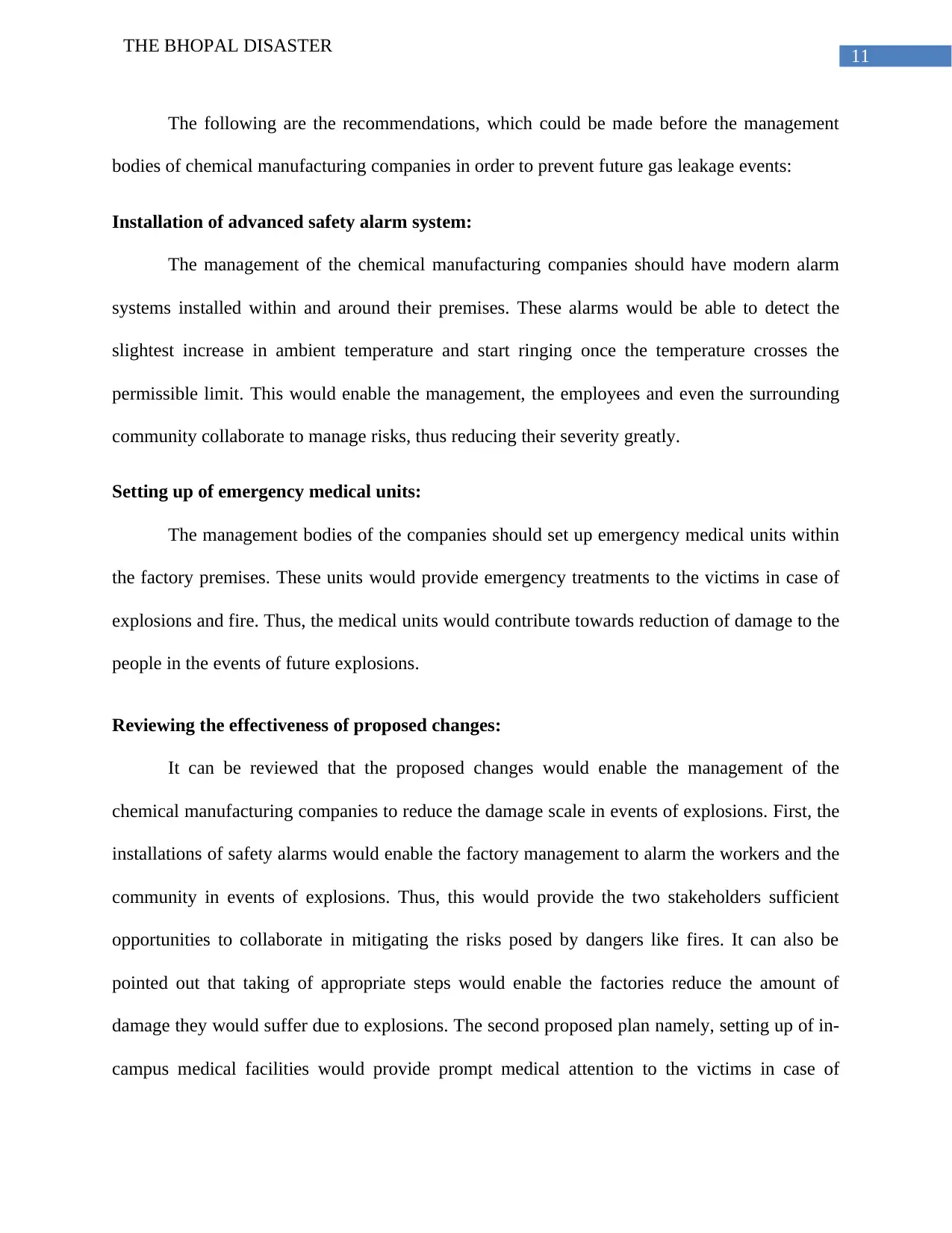
11
THE BHOPAL DISASTER
The following are the recommendations, which could be made before the management
bodies of chemical manufacturing companies in order to prevent future gas leakage events:
Installation of advanced safety alarm system:
The management of the chemical manufacturing companies should have modern alarm
systems installed within and around their premises. These alarms would be able to detect the
slightest increase in ambient temperature and start ringing once the temperature crosses the
permissible limit. This would enable the management, the employees and even the surrounding
community collaborate to manage risks, thus reducing their severity greatly.
Setting up of emergency medical units:
The management bodies of the companies should set up emergency medical units within
the factory premises. These units would provide emergency treatments to the victims in case of
explosions and fire. Thus, the medical units would contribute towards reduction of damage to the
people in the events of future explosions.
Reviewing the effectiveness of proposed changes:
It can be reviewed that the proposed changes would enable the management of the
chemical manufacturing companies to reduce the damage scale in events of explosions. First, the
installations of safety alarms would enable the factory management to alarm the workers and the
community in events of explosions. Thus, this would provide the two stakeholders sufficient
opportunities to collaborate in mitigating the risks posed by dangers like fires. It can also be
pointed out that taking of appropriate steps would enable the factories reduce the amount of
damage they would suffer due to explosions. The second proposed plan namely, setting up of in-
campus medical facilities would provide prompt medical attention to the victims in case of
THE BHOPAL DISASTER
The following are the recommendations, which could be made before the management
bodies of chemical manufacturing companies in order to prevent future gas leakage events:
Installation of advanced safety alarm system:
The management of the chemical manufacturing companies should have modern alarm
systems installed within and around their premises. These alarms would be able to detect the
slightest increase in ambient temperature and start ringing once the temperature crosses the
permissible limit. This would enable the management, the employees and even the surrounding
community collaborate to manage risks, thus reducing their severity greatly.
Setting up of emergency medical units:
The management bodies of the companies should set up emergency medical units within
the factory premises. These units would provide emergency treatments to the victims in case of
explosions and fire. Thus, the medical units would contribute towards reduction of damage to the
people in the events of future explosions.
Reviewing the effectiveness of proposed changes:
It can be reviewed that the proposed changes would enable the management of the
chemical manufacturing companies to reduce the damage scale in events of explosions. First, the
installations of safety alarms would enable the factory management to alarm the workers and the
community in events of explosions. Thus, this would provide the two stakeholders sufficient
opportunities to collaborate in mitigating the risks posed by dangers like fires. It can also be
pointed out that taking of appropriate steps would enable the factories reduce the amount of
damage they would suffer due to explosions. The second proposed plan namely, setting up of in-
campus medical facilities would provide prompt medical attention to the victims in case of
⊘ This is a preview!⊘
Do you want full access?
Subscribe today to unlock all pages.

Trusted by 1+ million students worldwide
1 out of 15
Related Documents
Your All-in-One AI-Powered Toolkit for Academic Success.
+13062052269
info@desklib.com
Available 24*7 on WhatsApp / Email
![[object Object]](/_next/static/media/star-bottom.7253800d.svg)
Unlock your academic potential
Copyright © 2020–2025 A2Z Services. All Rights Reserved. Developed and managed by ZUCOL.





